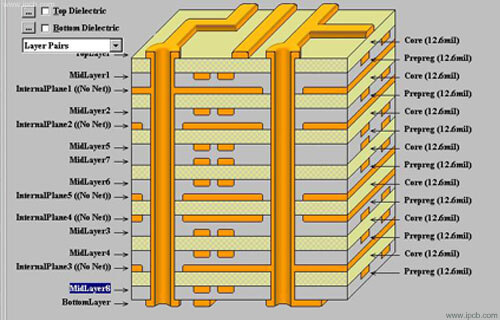1. Visual inspection
Because the layers in PCB are closely combined, it is not easy to see the actual number. However, if we observe the Banka fault carefully, we can still distinguish it. Be careful, we will find that there is a layer or several layers of white material in the middle of PCB. In fact, this is the insulation layer between each layer, which is used to ensure that there is no short circuit between different PCB layers. Because the current multi-layer PCB boards use more single or double-sided wiring boards, and put a layer of insulation layer between each layer of boards and then press together. The number of layers of PCB represents several independent wiring layers, and the insulation layer between layers has become the direct way to judge the number of layers of PCB.

2. Guide hole and blind hole alignment method
The guide hole alignment method uses the "pilot hole" on the PCB to identify the number of PCB layers. The principle is mainly due to the use of pilot hole technology in the circuit connection of Multilayer PCB. If we want to see how many layers there are in PCB, we can identify them by observing the pilot holes.
On a basic PCB (single-sided motherboard), parts are concentrated on one side and wires are concentrated on the other side. If you want to use a multilayer board, you need to punch holes in the board so that the component pins can pass through the board to the other side, so the pilot hole will punch through the PCB board. So we can see that the pin of the part is welded on the other side.
For example, if the board uses 4-layer boards, it is necessary to route lines in the first and fourth layers (signal layer), and the other layers have other uses (ground layer and power layer). The purpose of placing the signal layer on both sides of the power layer and ground layer is to prevent mutual interference and correct the signal line. If some card guide holes appear on the front of the PCB, but cannot be found on the reverse side, it must be a 6 / 8-layer board. If the same pilot hole can be found on both sides of PCB, it will be a 4-layer PCB.
However, at present, many board manufacturers use another routing method, that is, only connect some of the lines, and use the buried hole and blind hole technology in the routing. Blind hole is to connect several layers of internal PCB with surface PCB, which does not penetrate the whole circuit board.
The buried hole is only connected to the internal PCB, so it can not be seen from the surface. Because the blind hole does not need to run through the entire PCB, if it is six or more layers, look at the board facing the light source, and the light will not pass through. So there is also a very popular saying before: through the hole whether the light leakage to determine four layer and six layer or more PCB. This method has its own reason, but it is not suitable. It can be used as a reference method.
3. Accumulation method
To be exact, it is not a method, but an experience. But this is what we think is accurate. We can judge the number of layers of PCB by the routing of some PCB cards and the position of components. Because in the current IT hardware industry with such a rapid update, there are not many manufacturers with the ability to redesign PCB.
For example, a few years ago, a large number of 9550 graphics cards designed with 6-layer PCB are used. Can careful friends compare it with 9600PRO or 96000xt boards? Only some components are omitted, and the height is consistent on the PCB.
In the 1990s, there was a popular saying at that time: the number of layers of PCB can be seen by placing the PCB vertically, which is believed by many people. This statement was later proved to be absurd. Even if the manufacturing technology was backward at that time, how could the eyes distinguish it from the hair which was smaller than the hair? Later, this method continued and modified, and gradually evolved another measurement method. Nowadays, many people believe that the number of layers of PCB can be measured with precision measuring instruments such as vernier calipers. We can't agree with this statement.
And whether or not there is such a precise instrument, how can we not see that a 12 layer PCB is three times the thickness of a four layer PCB? Different PCB will adopt different manufacturing process, there is no unified standard to measure, how to judge the number of layers according to the thickness?
In fact, the number of PCB layers has a great impact on the board. For example, why do you need to use at least 6 layers of PCB to install Dual CPU? Because this allows the PCB to have 3 or 4 signal layers, 1 ground plane, 1 or 2 power layers. In this way, the signal lines can be separated far enough to reduce mutual interference, and there is enough current supply. However, the general board using 4-layer PCB design is fully enough, using 6-layer PCB is too wasteful, and there is not much performance improvement.